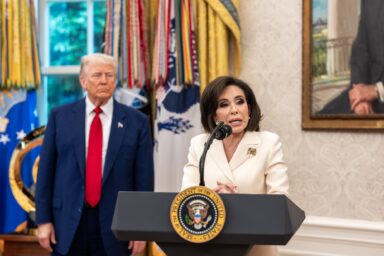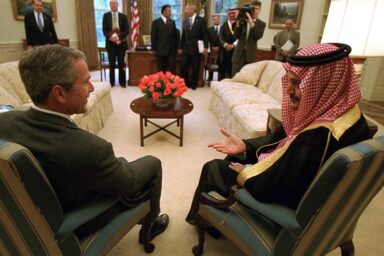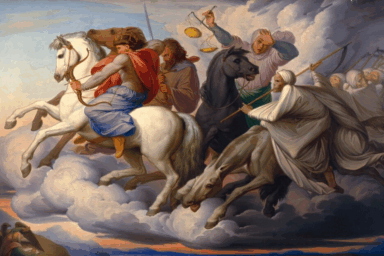Getting down and dirty — way down, and real dirty.
PERSPECTIVE
This is Part 3 of a four-part series. Read Part 2 here.
Regardless of the topic, the tactic of throwing out mutually contradictory “versions” always seemed to work for the debate’s predetermined winners:
The novel coronavirus was an American bioweapon genetically modified to infect only people of “Mongoloid” ethnicity, and the US was failing to cope with wave after wave of COVID-19 infections at home.
Minneapolis police officers were sadist pigs, and peaceful protesters against police violence were destroying America.
Leading Kremlin critic Alexei Navalny had faked his own poisoning. Leading Kremlin critic Alexei Navalny had really been poisoned by “Anglo-Saxon” intelligence operatives in an attempt to discredit Russia’s Sputnik V COVID-19 vaccine.
The North Atlantic Treaty Organization (NATO) had relentlessly destroyed Afghanistan for 20 years. NATO troops’ withdrawal from Afghanistan was step 12 in a CIA plot to destabilize the entire Central Asian region.
Ukraine was the place d’armes for the democratic world’s coming invasion of Russia. Ukraine’s corrupt authoritarian ruling class would soon be fleeing the country with suitcases full of dollars.
Again, it did not matter if I agreed that at least one Minneapolis police officer was a sadist pig; if I said so on the air, I would be lectured about my collective guilt in the latest desecration of a Christopher Columbus monument. I would be lectured about my collective guilt in each and every one of America’s indisputably awful historical actions, from slavery to Cherokee genocide to Operation Iraqi Freedom.
No matter what I said, I was always wrong, and no matter what a “patriotic” “expert” said, he was always right — even if, on occasion, we were saying exactly the same thing.
On the other hand, if anyone on the “liberal” side pointed out that the “patriots” were actually in complete disagreement with one another, the hosts would simply meet this observation with feigned confusion, derisive laughter, or with a theatrical lecture about anything other than the topic at hand. The show’s message to the at-home audience was clear: Russia is right, and its critics are wrong, no matter what.

The domestic Russian fantasy world operation has proven to be a resounding success. The majority of Russian citizens believes the Ukrainian government — headed by Volodymyr Zelenskyy, a Russian-speaking former comedian of Jewish heritage — is controlled by Russophobic neo-Nazis.
For almost eight years, the Russian population was primed to believe that any hypothetical Russian tank crew crossing the border into Ukraine would be met in Kharkiv, Kherson, Kyiv, and Odessa with literal bread and salt.
It appears increasingly likely that the Kremlin leadership had convinced itself of the same fantasy.
Somehow, nearly every Moscow-based Western correspondent and international “Russia watcher” missed the Russian war crime being planned in plain sight.
Talk of war on Russian TV actually started in late March 2021, when Russia began moving military hardware from the Far East toward its border with Ukraine. Although Russian Defense Minister Sergei Shoigu announced on April 22 that these “snap exercises” had been completed successfully, he did not explain why domestic Russian propaganda had been conscripted into the drill.
For the first three weeks of April, television viewers from Arkhangelsk to Astrakhan were being shouted at every afternoon and evening about the high likelihood that Ukrainian forces were preparing a military offensive aimed at taking back those Russian-controlled “separatist” Donbas enclaves. After Shoigu’s announcement, however, the talk shows returned to Biden-bashing.
The tanks and materiel transferred west as part of those “snap exercises” remained conspicuously present on Russian bases along its border with Ukraine.
In November, reputable Western media outlets began publishing authorized leaks from American government officials about a Russian plan to invade Ukraine. Russian domestic propaganda presented the articles as one more example in a familiar-by-now line of “Russophobic fake news,” and even I was skeptical at first that an invasion really was possible.
In the weeks leading up to the holidays this past December, as the Russian military buildup continued, Russian domestic propaganda denied that anything unusual was happening. Either the US government’s official statements about continuing material movements had been invented as part of the “Anglo-Saxon information war” against Russia, or else the TikTok videos of Russian tanks en route to Ukraine were merely an example of the Kremlin defending its sovereignty.
On the talk shows, I had repeatedly asked the assembled Duma deputies and military experts exactly what the Russian response would be when, not if, its unrealistic security demands were rebuffed. If Russia were interested in arms control talks, or in reestablishing formal diplomatic ties between Moscow and NATO, then agreement on such secondary questions could certainly be reached.
In mid-December, the evening show’s host stopped inviting me onto his program after I refused to go along with his assertion that the so-called Russian military buildup was nothing more than a phantom of Joe Biden’s demented imagination.
The answer was always the same: NATO’s 1998 expansion into Eastern Europe, along with its 2004 enlargement to include the Baltic states, posed a direct existential threat to the Russian state.
The flight time for rockets from Kharkiv to Moscow was a mere five minutes; the Ukrainian government’s “Anglo-Saxon curators” were planning a “provocation” to draw Russia into a war that the Kremlin was strenuously trying to avoid. As usual, it was impossible to ask any on-air follow-up questions.
In the green room after the show, these officials and “experts” frequently cited “70 percent” as the proportion of Ukrainian officers who would immediately defect to the Russian side in the event of a conflict. They really had closed their eyes and ears.
Every on-air chance I got, I pointed to the map on the studio floor and recited the numbers of the Russian armies surrounding Ukraine on three sides. Every time I did, the hosts dismissed it as Russophobic scaremongering.
In mid-December, the evening show’s host stopped inviting me onto his program after I refused to go along with his assertion that the so-called Russian military buildup was nothing more than a phantom of Joe Biden’s demented imagination.
A week after that particular falling out, the Russian Ministry of Foreign Affairs published the contents of two draft treaties calling for NATO and the US to formally recognize Moscow’s “security concerns.” The treaties demanded that NATO permanently forswear any further expansion, that it roll back all European military infrastructure to the alliance’s 1997 borders, and that all NATO members refrain from any future cooperation with Ukraine.
If the Russian demands were not met, then Russia would be compelled to undertake an unspecified “military-technical response.” A prominent Russian foreign affairs commentator likened the situation to threatening Santa Claus with violence if he did not deliver “a unicorn — a real live unicorn.”
By mid-January, it was clear to anyone following Russian domestic propaganda that Russia’s Potemkin diplomatic “efforts” had failed. Following three days of meetings between Russian officials and representatives of the US, NATO, and the Organization for Security and Co-operation in Europe, Russian Foreign Minister Sergey Lavrov announced that “our patience has reached its end.” The following week, the Russian airwaves were full of speculation as to when exactly the Ukrainian “provocation” in the Donbas would occur — and which chemical weapons it might include.

Somehow, nearly every Moscow-based Western correspondent and international “Russia watcher” missed the Russian war crime being planned in plain sight.
My attempts to draw my fellow Westerners’ attention to the actual evidence went about as well as it did with my Russian interlocutors.
I spent close to two months failing to find a “rational” explanation for Russia’s military buildup, falling out with Russian friends and getting Twitter blocked by Mark Galeotti, the director of Mayak Intelligence — a London-based research firm concentrating on Russia — in the process. It was true that just about no one in Russia itself believed that a war was likely.
The problem was, I knew exactly where most Russians were getting their worldview, and I understood exactly where their interpretation of events had been manipulated. When on-the-ground-in-Moscow reporters went to their trusted sources, I knew exactly why those trusted sources believed in the make-believe they believed in.
And so, on the evening of Sunday, February 20, at a little birthday celebration attended by a collection of relatively liberal Russian professors, economists, and political advisers, I listened patiently to everyone else’s explanations as to why nothing much was going to happen — maybe the Russian army would openly occupy Donetsk and Luhansk, but it didn’t make any real world sense for the invasion force taking up positions in the forests 200 kilometers (124 miles) north of Kyiv to actually cross the border; therefore, the Russian tanks and troops camping out in the snow were just going to stay put.
When my turn came and I assured all assembled that Russian troops would be in the suburbs of the Ukrainian capital by the end of the week, it was taken as proof that no outsider could ever hope to understand the complexities of the Russian soul.
Somehow, just about no one in Moscow saw this coming.
This is Part 3 of a four-part series. Read Part 4 here.
Michael Wasiura is a freelance writer. A graduate of the University of Michigan, he received a Master’s Degree in International Economic Analysis from Fordham University, then taught English in Moscow before becoming a fixture on Russian television.




